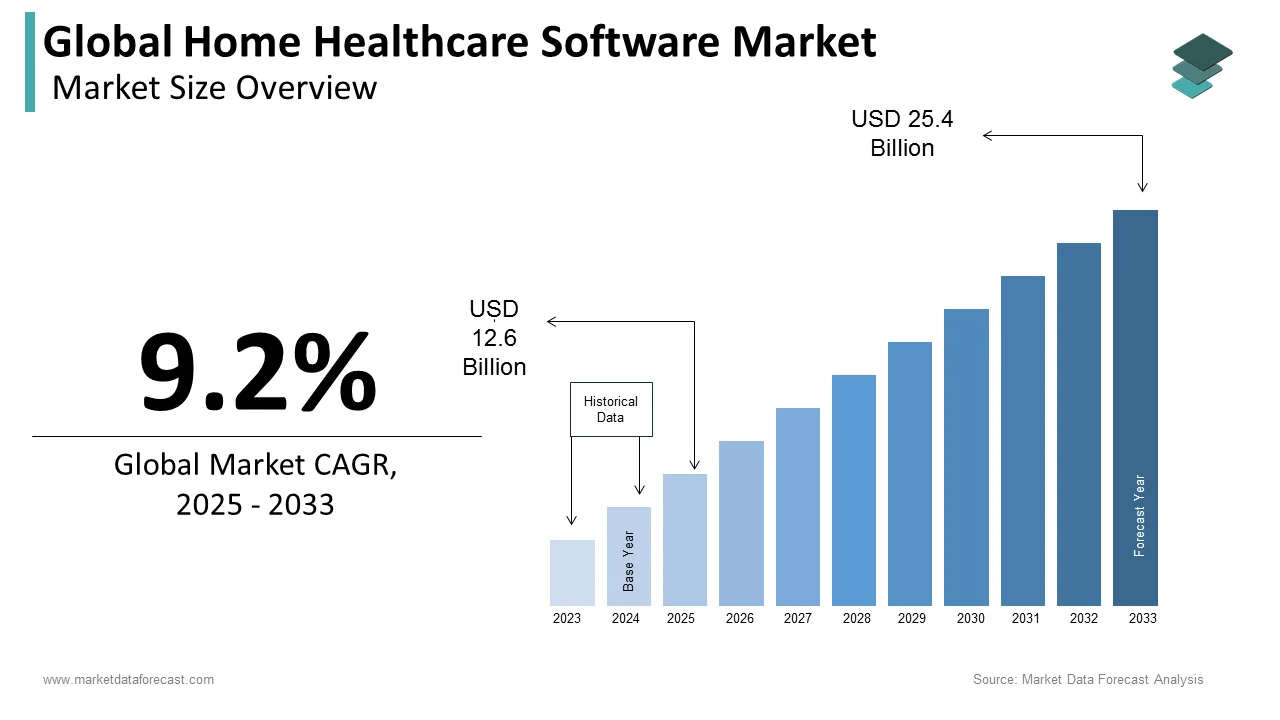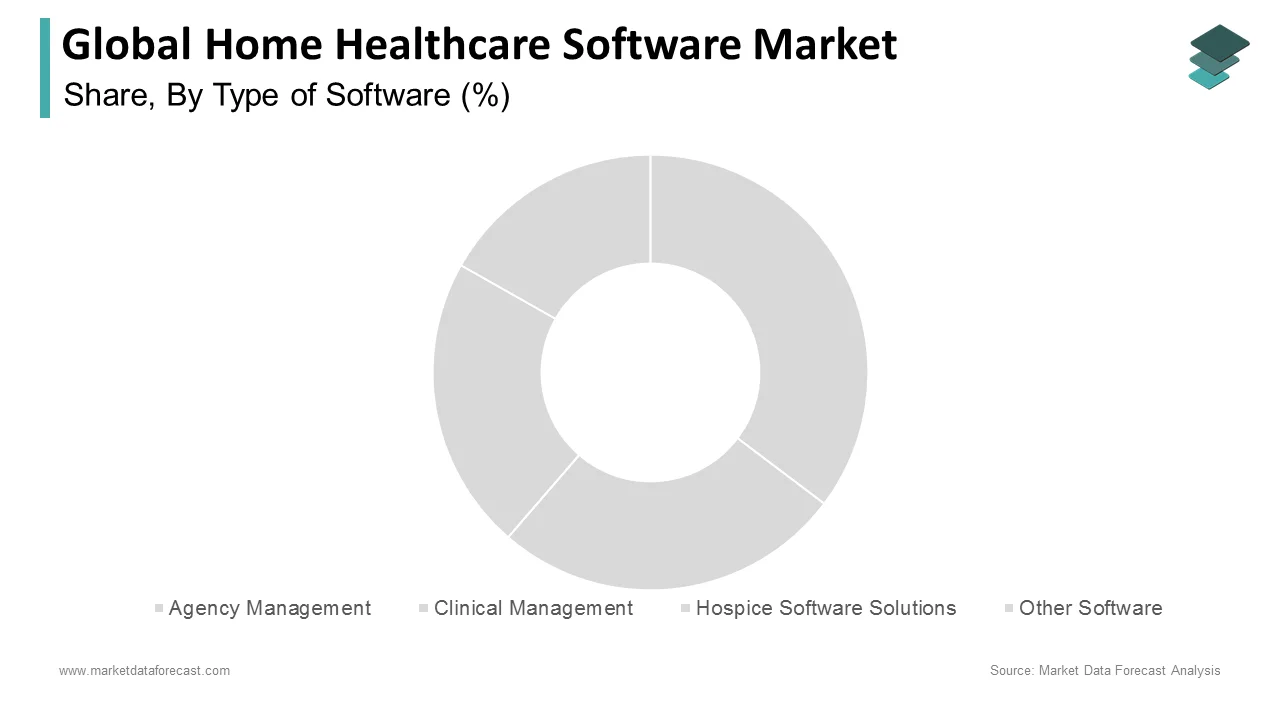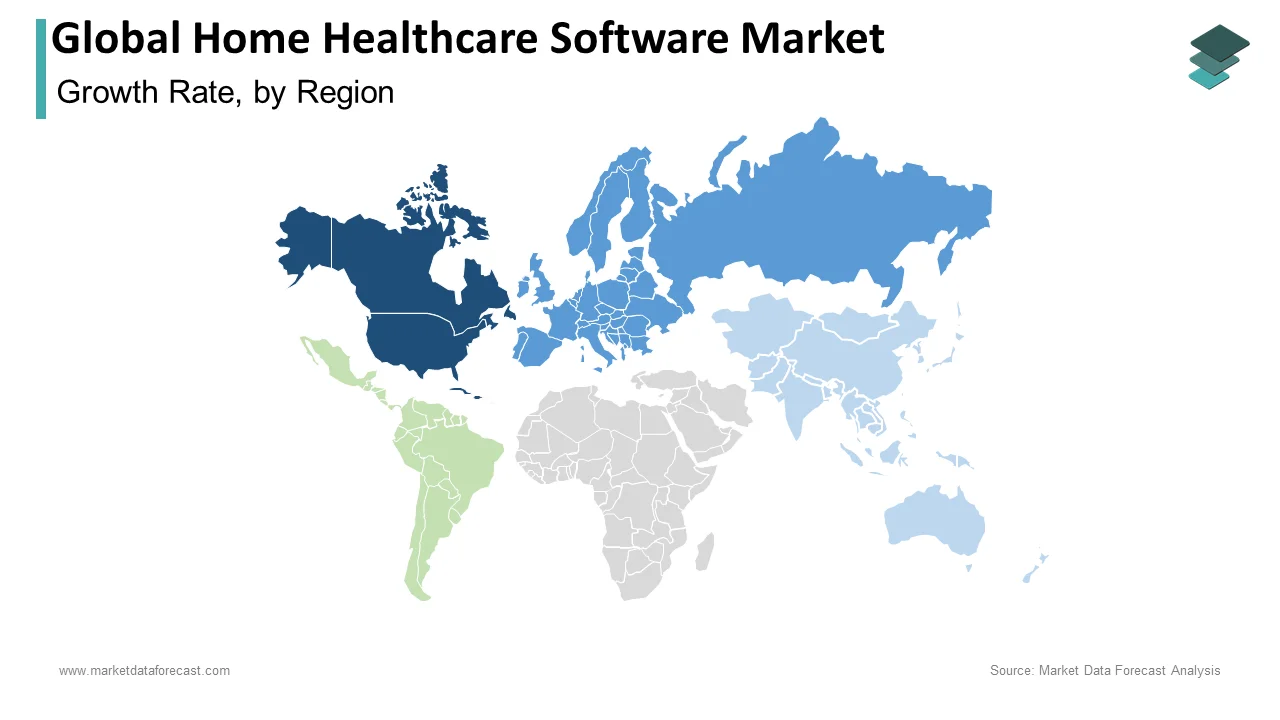Global Home Healthcare Software Market Size, Share, Trends & Growth Forecast Report By Type of Software, Service, Mode of Delivery and Region (North America, Europe, Asia-Pacific, Latin America, Middle East and Africa), Industry Analysis From 2025 To 2033.
Global Home Healthcare Software Market Size
The global home healthcare software market was worth US$ 11.5 billion in 2024 and is anticipated to reach a valuation of US$ 25.4 billion by 2033 from US$ 12.6 billion in 2025, and it is predicted to register a CAGR of 9.2% during the forecast period 2025-2033.

Home healthcare is a good replacement for people who take medical home by staying at home instead of in a hospital or clinic. Home healthcare professionals take care of people who are unwell, injured, or aged. Home healthcare software is primarily used by service-providing companies or governments that offer home healthcare services. Home healthcare software is vital in executing home healthcare services most effectively. Using the software, various aspects such as patient information, schedule of caregivers, managing payments, and equipment can be tracked. Home healthcare software makes it much easier to provide patients with therapy and rehabilitation services. Billing, paying, scheduling, and organizing company documents can be done effortlessly by using home healthcare software.
MARKET DRIVERS
Growing adoption of home healthcare, YOY growth in the aging population, and the incidence of accidents worldwide are primarily expected to drive the growth of the global home healthcare software market.
Most home healthcare services are used to manage the medical needs of the aged population. Hence, the growing aging population worldwide is anticipated to promote the usage of home healthcare services and home healthcare software. According to World Health Organization (WHO), the percentage of people 60 years of age worldwide is expected to rise from 12% in 2015 to 22% by 2050. The aging population is expected to be 1.4 billion by 2030 and 2.1 billion by 2050. In addition, the growing number of accidents happening worldwide daily is expected to promote the need for home healthcare services and result in the growth of the home healthcare software market. People suffering from road accidents prefer taking treatment from home after spending the required time in hospitals using the home healthcare model. The U.S. holds the top spot in the number of accidents each year. According to the National Highway Traffic Safety Administration (NHTSA), 42915 people died in vehicle crashes in the United States in 2021.
Technological advancements are further projected to accelerate the global home healthcare software market growth.
The adoption of technological developments is growing among people. People use various digital tools to manage their medical needs, including home healthcare software. The awareness among people regarding the benefits associated with using home healthcare software, such as access to their electronic health records (EHR), has risen, and the developments in mobile health and telehealth apps are making it possible for the home healthcare market participants to monitor the patients without asking them to come to the hospital or clinic. The usage of home healthcare software manages various tasks, such as managing staff, payments, and patient and physician information.
MARKET RESTRAINTS
High costs associated with home healthcare software are primarily hindering growth in the global market.
The implementation of home healthcare software can be expensive, which is directly impacting the market growth. In addition, data privacy concerns associated with the usage of home healthcare software are further inhibiting the growth of the home healthcare software market. Home healthcare software contains sensitive patient information and medical records, which can be at risk of being stolen or leaked, which has become a serious concern among the patient group and hampering the adoption rate.
REPORT COVERAGE
|
REPORT METRIC |
DETAILS |
|
Market Size Available |
2024 to 2033 |
|
Base Year |
2024 |
|
Forecast Period |
2025 to 2033 |
|
CAGR |
9.2% |
|
Segments Covered |
By Type of Software, Service, Mode of Delivery, and Region. |
|
Various Analyses Covered |
Global, Regional, and country-level analysis; Segment-Level Analysis, DROC; PESTLE Analysis; Porter’s Five Forces Analysis, Competitive Landscape; Analyst Overview of Investment Opportunities |
|
Regions Covered |
North America, Europe, APAC, Latin America, Middle East & Africa |
|
Market Leaders Profiled |
Allscripts Healthcare Solutions, Carestream Health, GE Healthcare, NextGen Healthcare Information System LLC, Siemens Healthcare, Novarad Corporation, MEDITECH, Cerner Corporation, Agfa Healthcare, WellSky, Medical Information Technology, Inc. (Meditech), Continulink, and Others. |
SEGMENTAL ANALYSIS
By Type of Software Insights

The hospice software solutions segment is anticipated to hold a major share of the home healthcare software market during the forecast period and is also expected to register the fastest CAGR. Hospice and palliative care organizations provide medical solutions to people with terminal illnesses and who are dealing with end-of-life issues. The hospice software solutions help organizations handle various tasks such as scheduling and coordinating caregivers, payments, and maintaining electronic health records and other documents. It further plays a bridge role and fills communication gaps between the patient, healthcare provider, and family. Therefore, these hospice software solutions are considered a powerful tool to improve the efficiency and effectiveness of hospice and palliative care organizations and provide high-quality healthcare to people.
By Service Insights
The rehabilitation segment is expected to be the fastest-growing segment in the global home healthcare software market during the forecast period. The usage of home healthcare software is high among rehabilitation centers, and this usage has further increased during the COVID-19 pandemic, primarily supporting the segment's growth. Rehabilitation services can be offered in a home setting and are required for patients recovering from an injury or surgery. In addition, it is also used for people with chronic medical conditions requiring continuous therapeutic intervention.
By Mode of Delivery Insights
The cloud-based deployment was the most popular option and held the major share of the global home healthcare software market in 2022. The cloud option is most preferred considering the security issues for mobile and web healthcare applications. Compared to on-premises deployment, the cloud is more flexible. In addition, it provides better customization features, due to which the adoption of the cloud segment is growing rapidly and showing domination in the home healthcare software market.
REGIONAL ANALYSIS

Based on the region, the North American home healthcare software market had the largest global market share in 2021. North America is expected to continue leading the market throughout the forecast period. The regional market's growth is primarily driven by the availability of modern healthcare IT infrastructure in healthcare institutions that is compatible with the integration of home healthcare software. The demand for home healthcare services has been increasing considerably in the North American region, which is further estimated to result in the regional market for home healthcare software. The growing support from the federal government is anticipated to favor the market growth in the North American region. The U.S led the market in North America, followed by Canada in 2021. The market growth in the U.S. is majorly fuelled by the growing adoption of technological developments and increasing healthcare costs. In addition, the growing awareness among people regarding home healthcare is further propelling the market growth in the U.S.
The European home healthcare software market held a substantial share of the global market in 2021 and is projected to grow at a promising CAGR during the forecast period. The usage of home healthcare services is significantly growing across the European region, which is expected to propel the home healthcare software market in Europe. The majority of the Europe market share was controlled by the United Kingdom, Germany, and France in 2021, which was approximately 64%. On the other hand, EU countries such as Russia and Poland are expected to contribute significantly to the European region in the coming years.
The Asia-Pacific home healthcare software market is predicted to grow the fastest among all regions in the global market during the forecast period. Factors such as growing disposable income, increasing expenditure on healthcare by governments, and a growing number of IT developments in countries such as India and China are majorly propelling the market growth in the Asia-Pacific region. In addition, the growing investments by the market participants in the Asia-pacific region and the presence of emerging economies are expected to contribute to the growth of the APAC home healthcare software market.
The Latin American home healthcare software market is anticipated to hold a considerable share of the global market during the forecast period.
The home healthcare software market in MEA is estimated to grow at a steady CAGR during the forecast period.
KEY MARKET PLAYERS
Allscripts Healthcare Solutions, Carestream Health, GE Healthcare, NextGen Healthcare Information System LLC, Siemens Healthcare, Novarad Corporation, MEDITECH, Cerner Corporation, Agfa Healthcare, WellSky, Medical Information Technology, Inc. (Meditech), and Continulink are some of the promising companies operating in the home healthcare software market.
MARKET SEGMENTATION
This research report on the global home healthcare software market has been segmented and sub-segmented based on the type of software, service, mode of delivery, and region.
By Type of Software
- Agency Management
- Clinical Management
- Hospice Software Solutions
- Other Software
By Service
- Rehabilitation
- Infusion Therapy
- Respiratory Therapy
- Pregnancy Care
- Skilled Nursing
- Others
By Mode of Delivery
- Cloud-Based Software
- On-Premises Software
- Others
By Region
- North America
- Europe
- Asia-Pacific
- Latin America
- Middle East and Africa
Frequently Asked Questions
At What CAGR, the global home healthcare software market is expected to grow from 2025 to 2033?
From 2025 to 2033, the global market for home healthcare market is projected to be growing at a CAGR of 9.2%.
Does this report include the impact of COVID-19 on the home healthcare software market?
Yes, the COVID-19 impact on the global home healthcare software market is included in this report.
Which region led the home healthcare software market in 2024?
Geographically, the North American regional market dominated the home healthcare software market in 2024.
Which are the significant players operating in the home healthcare software market?
Allscripts Healthcare Solutions, Carestream Health, GE Healthcare, NextGen Healthcare Information System LLC, Siemens Healthcare, Novarad Corporation, MEDITECH, Cerner Corporation, Agfa Healthcare, WellSky, Medical Information Technology, Inc. (Meditech), and Continulink are some of the promising companies operating in the global home healthcare software market.
Related Reports
Access the study in MULTIPLE FORMATS
Purchase options starting from $ 2500
Didn’t find what you’re looking for?
TALK TO OUR ANALYST TEAM
Need something within your budget?
NO WORRIES! WE GOT YOU COVERED!
Call us on: +1 888 702 9696 (U.S Toll Free)
Write to us: [email protected]
